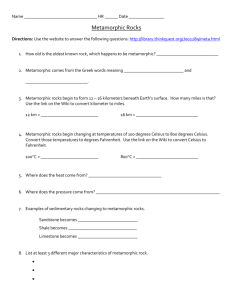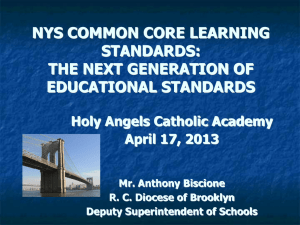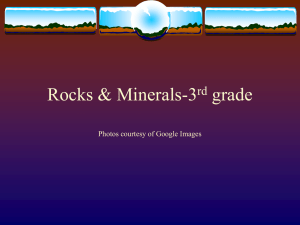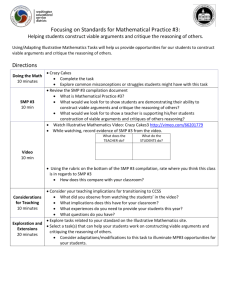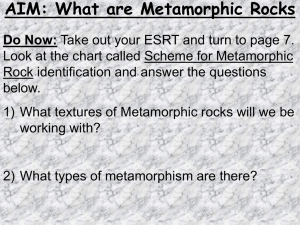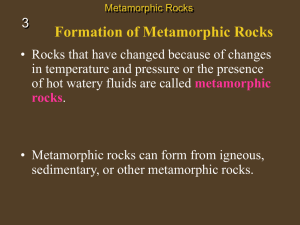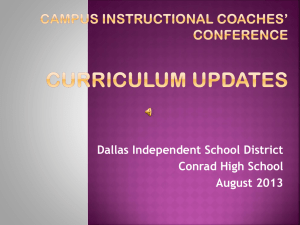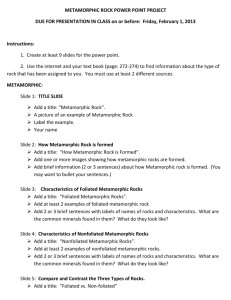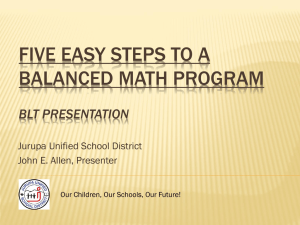Prompts Project Based Learning - Global Center For College
advertisement
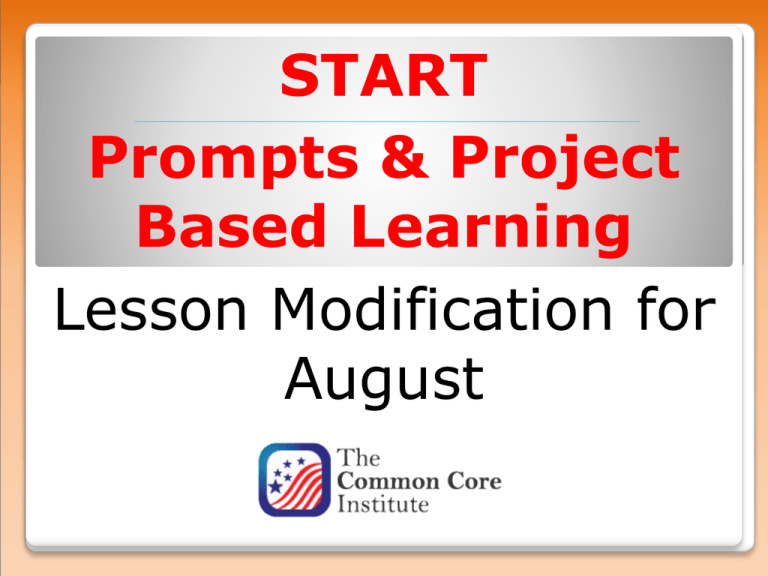
START Prompts & Project Based Learning Lesson Modification for August Agenda 1. 2. 3. 4. 5. Performance and Product Prioritize: Gaps Apply Deconstruction or.. Basic Lesson Modification TO DOS Reading Inference Evidence Analyze Summarize Interpret Integrate Evaluate Delineate Math Mathematically proficient students can… Explain meaning Conjecture Reason abstractly Critique Reasoning The CCSS for Mathematics compel a change in the culture of traditional mathematics classroom. In the typical mathematics classroom students are “too busy covering content” to be engaged with mathematics. The CCSS attempt to tell teachers when to slow down and emphasize student understanding of significant mathematical ideas. O O c Thoughts? How do we “quickly” “easily” Implement? The Bad News Someone Has to Understand Deconstruction Analyze the wording of the standard to determine key concepts, key skills, and the ultimate type of learning target. 1.Identify nouns and noun phrases to identify key concepts 2.Locate verbs to identify key target(s) 3.Place the targets into one or more categories 4.Clarify any terms that may lead to misinterpretation 5.Construct a list of skills that are essential to become proficient in the identified standard Represent a fraction 1/b on a number line diagram by defining the interval from 0 to 1 as the whole and partitioning it into b equal parts. Recognize that each part has size 1/b and that the endpoint of the part based at 0 locates the number 1/b on the number line. Represent a fraction a/b on a number line diagram by marking off a lengths 1/b from 0. Recognize that the resulting interval has size a/b and that its endpoint locates the number a/b on the number line. 1. Identify the key concepts: intervals, endpoint, interval size 2. Determine type(s) of learning target(s) partition, define, locate, represent, express Respond thoughtfully to diverse perspectives; synthesize comments, claims, and evidence made on all sides of an issue; resolve contradictions when possible; and determine what additional information or research is require to deepen the investigation or complete the task. Concepts: diverse perspectives, comments, claims, evidence, contradictions, investigation Targets: respond (thoughtfully), synthesize, resolve , determine Although the Common Core State Standards are more clear than many state standards, they are still open to multiple interpretations Standards are not meant to be mastered in one learning opportunity ◦ Meant to be mastered via smaller learning targets over time Educators and students require common, clear learning targets A systematic process to identify embedded learning targets in standards so that nothing essential is missed during instruction Learning targets: What students should know, understand and be able to do to master the standards Sequence the targets into a developmentally appropriate learning progression Classifying Targets Knowledge Mastery of substantive subject content where mastery includes both knowing and understanding it. Reasoning The ability to use knowledge and understanding to figure things out and solve problems. Performance The development of proficiency in doing something where it is the process that is important such as playing a musical instrument, reading aloud, speaking in a second language or using psychomotor skills. Products The ability to create tangible products, such as term papers, science fair projects, and art sculptures that meet certain standards of quality and present concrete evidence of academic proficiency. • Identify sight words • Identify similes and metaphors • List defining characteristics of various literary genres • Count and group concrete manipulatives by ones, tens, and hundreds to 1,000 • Make a prediction based on evidence • Distinguish between fact and opinion • Evaluate information from a variety of resources • Classify and compare triangles by sides and angles • Read aloud with fluency and expression • Demonstrate the use of selfcorrection strategies • Find and justify the laws of exponents with numeric bases using inductive reasoning • Model, identify and describe square, prime and composite numbers • Produce a grammatically correct sentence • Develop a proper paragraph form in a written composition • Compose a written composition using the five-step writing process • Create a design with more than one line of symmetry • How would you describe a “learning target”? • Why are they important? • How do they relate to the Standards – current or CCSS? Begin by analyzing the level of thinking required by the standard Assess the degree of depth or complexity of knowledge reflected in the content standards and assessments Determine how deeply a student needs to understand the content for a given response/assessment 1. Describe three characteristics of metamorphic rocks 2. Describe the difference between metamorphic and igneous rocks 3. Describe a model that you might use to represent the relationships that exist within the rock cycle Verbs alone do not determine the level of cognitive demand required by the indicator; be certain to examine all contextual elements Same verb (Describe); Three Types of Targets 1. Describe three characteristics of metamorphic rocks ◦ Knowledge (simple recall) 2. Describe the difference between metamorphic and igneous rocks ◦ Reasoning (requires cognitive processing to determine the differences in the two rock types) 3. Describe a model that you might use to represent the relationships that exist within the rock cycle ◦ Performance (requires deep understanding of rock cycle and a determination of how best to represent it) Analyze the wording of the standard to determine key concepts, key skills, and the ultimate type of learning target. 1.Identify nouns and noun phrases to identify key concepts 2.Locate verbs to identify key target(s) 3.Place the targets into one or more categories 4.Clarify any terms that may lead to misinterpretation 5.Construct a list of skills that are essential to become proficient in the identified standard Applying the Gap Maps Activity: How do we use GAPS in Curriculum? Lesson Modification 1. 2. 3. 4. Lesson / Content Standards / ADD GAP Skills / ADD GAP Operation / MODIFICATION Identifying GAPS with TOOLS MODIFY/ ADD: CC.6.W.1 Text Types and Purposes: Write arguments to support claims with clear reasons and relevant evidence What is the Author’s main point in the poem? Support your answer with three pieces of evidence. Grade K Grade 1 Grade 2 Standard: Author’s Purpose: Argue & Support Claims Course Analysis: All Standards Covered? National Pathway Phase I Create GAP MAPs Modify / START Analyze / Refine What Are The ELEMENTS of “College & Career Readiness”? Edutopia.org http://www.bie.org/ internet4classrooms.com PBL Elements • • • • • • • Long Term Project (Not a Worksheet) Interdisciplinary REAL WORLD Relevance (makes Rigor Possible!) Student-organized work Collaboration / Speaking Artifact Construction PBL Elements • Open-ended Driving Question / Challenge • Creates a need to know essential content and skills • Requires inquiry to learn and/or create something new. • Requires critical thinking, problem solving, collaboration, and various forms of communication. Allows some degree of student voice and choice. Incorporates feedback and revision. Students use peer critique to improve their work to create higher quality products. Results in a publicly presented product or performance. What you know is demonstrated by what you do, and what you do must be open to public scrutiny and critique. YOUR PROJECT Just One Project PBL Elements • Open-ended Driving Question • Know essential content and skills • Requires inquiry to learn / create new • Requires critical thinking • Allows some degree of student voice and choice. • Incorporates feedback and revision. • Results in a publicly presented product or performance. Timeline 1. 2. 3. 4. 5. 6. Target grades One Project / month (Curr Teams) Principal Classroom Observation Include Rigor Be Careful about Chaos Integrate into Lesson Plan Process Share Rubrics, Share Projects What is An Engaged Classroom? st 21 Century Learning? Questions? Chairman @CurriculumInstitute. Org
